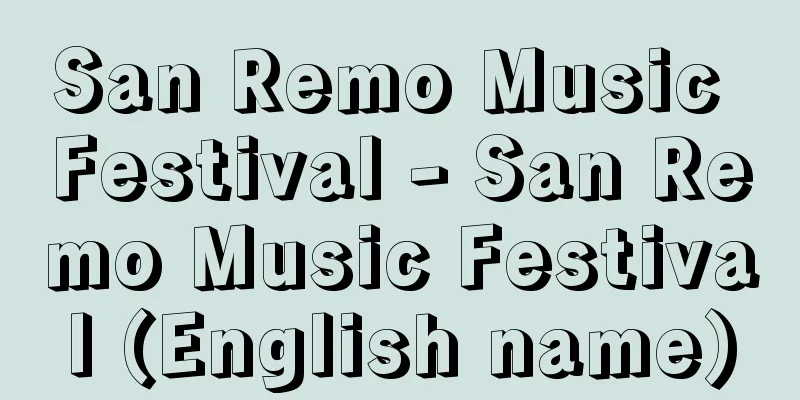Culture of the Bunka Era

|
The townspeople's culture centered in Edo around the Bunka and Bunsei eras (1804-1830). It is also called Oedo culture. In a broader sense, however, it refers to the culture of the long period from the late 18th century to the early 19th century, so its style is wide-ranging and its content is complex and diverse. It is centered on petty bourgeois rationalism and aesthetic sentiment, but because it was a time of relaxation in the feudal domain system, it is characterized by a strong emphasis on lifestyle and entertainment elements on the one hand, as well as political and critical elements on the other. [Kazuhiko Takao] The culture of leisure in everyday lifeAround the time of the Meiji Restoration, both in urban and rural areas, socializing and education became a part of the everyday life of the people. The reason for this was the expansion of leisure in the lives of the people and their enjoyment of a culture of life. There were events such as Himachi, Twenty-third Night Waiting, and Koushinmachi, in which people wait for the sunrise on the nights of the full moon in New Year's, May, and September, which were semi-entertainment events. In Edo, there were annual events as seen in the Toto Saijiki (written by Saito Gesshin, 1836), and religious events for members of groups such as the Ise-ko and Fuji-ko, but all of these were flourishing lifestyles and cultures based on socializing. The education of the common people was also varied, including academics, customs, indoor arts, and theatrical arts. In terms of indoor arts, there was ikebana, tea ceremony, incense ceremony, waka, calligraphy, painting, renga, haiku, go, and shogi, all of which could be said to be stable education in lifestyle and culture under the guidance of a head of a school. Of particular interest was the somewhat intellectual social interactions of intellectuals who exceeded the ranks of samurai and townspeople. It was in this period that Japanese painters Maruyama Okyo, Goshun (Matsumura Gekkei), and Ito Jakuchu were born, and literati painters Tanomura Chikuden and Watanabe Kazan flourished. The representative work of this genre, "Ten Conveniences and Ten Pleasures," a joint work by Ike no Taiga and Yosa Buson, can be said to be the epitome of elegance. It was also during this period that Western copperplate painters Shiba Kokan and Aodo Denzen emerged. In the popular world, Suzuki Harunobu's beautiful women paintings, particularly ukiyo-e and nishikie, were born from exchanges of illustrated calendars between bannermen and bill-brokers in Edo. Harunobu's graceful beauties were followed by Torii Kiyonaga, Kitagawa Utamaro, Utagawa Kunisada, and Keisai Eisen, whose works such as Utamaro's "The Ten Bodies of Women's Physiognomy" and Eisen's "A Competition for Women in the Ukiyo-e World" express the beauty of the "spirit" and "energy" of Edo women. Going beyond the elegant and popular, Hokusai Manga and Kazan's "A Hundred Types of Sweeping" are excellent in their vivid portrayals of the common people. In poetry, Karai Senryu's "Haifu Yanagi Daru," Ota Nanpo's Kyoka, and Issa's "Oraga Haru" became famous. In novels, short pleasure village stories, or sharebon, and their illustrated versions, or kibyoshi, were born, and are full of intellectual games of the connoisseur and "ugachi." Santo Kyoden compiled these stories, and his sharebon "Keiseikaishijuhatte" is his masterpiece. Next, Shikitei Sanba's humorous stories "Ukiyodoko" and "Ukiyoburo" depict human nature and customs, Ryutei Tanehiko's illustrated story collection "Nisemurasaki Inakagenji" vividly depicts the contemporary world in line with the classics, and Tamenaga Shunsui's human interest story "Shunshoku Umegoyomi" asserts the human feelings of ordinary men and women. All of these are the products of the leisure of everyday life. Furthermore, gardening, such as morning glory cultivation, which became popular around the time of the Bunka era, and storytelling at the vaudeville halls, as seen in Terakado Seiken's "Edo Hanjoki" (1832-1836), are also products of lifestyle culture. [Kazuhiko Takao] An outside unknown experienceThe leisurely life of the common people enabled them to venture into the unknown outside world, and it became clear that such experiences were beneficial for human growth. First, in terms of the secular aspect, there were travel experiences such as sightseeing trips and hot spring cures. A pilgrimage to Ise Shrine was in fact intended as a tour of Kyoto, Osaka, and other places. Records of such trips became the travelogues and observation notes of Tachibana Nankei, Sugae Masumi, Suzuki Bokushi, and others. A representative example would be Shiba Kokan's "Nagasaki Saiyuuryotan." Jippensha Ikku's humorous story "Tokaido Chu Hizakurige" is also an example of such experiences that was easily accessible to the common people. Ukiyo-e landscape prints such as Katsushika Hokusai's Thirty-six Views of Mount Fuji and Ando Hiroshige's Fifty-three Stations of the Tokaido conveyed unknown experiences, and for those who had already traveled, they were visual records of the poetic sentiment of travel. Next, in terms of religion, there were pilgrimages to Ise, Zenkoji, and Konpira, and there was also a trend of hoping for the same effect by visiting a thousand shrines, rather than visiting one hundred times. In the midst of a demand to go out, it was only natural that pilgrimages to the 33 sacred sites of Bando, Chichibu, Edo, and the west country became popular. Furthermore, the belief in climbing high mountains also became popular. Since the Horeki era (1751-1764), Fuji-ko sects have spread throughout the Kanto region, with Edo at their center, and every year some members of the sect actually climb to the summit. The shogunate has repeatedly issued bans and oppressed Fuji-ko sects. In 1828 (Bunsei 11), the nembutsu ascetic Banryu and his companions succeeded in climbing the unclimbed Mount Yari in the Northern Alps, enshrining a Buddha statue there and opening the way for people to worship it. [Kazuhiko Takao] Creating an extraordinary worldIt became possible to create and enjoy a world completely different from everyday life in the world of festivals, theater, and literature. First, as can be seen in the town notices of the Bunsei era, masks and costumes were popular at small festivals held at Kanda and Sanno shrines in Edo and other towns. Next, the tradition of Edo Kabuki had accumulated to the point that the Kabuki Chronicle (1804) was compiled, and the development of its gorgeous world was noteworthy. The Kyoto Kanoko Musume Dojoji (1753) was an elegant work that became the definitive version of Kabuki dance and music. Also, after Iwai Hanshiro's Shichihenge Dance (1806), variations of a continuous dance piece in which one person dances in quick succession became popular, and the public became intoxicated with the extraordinary gorgeous world. Tsuruya Namboku's "Yotsuya Kaidan: The Tōkaidō" (Tōkaidō Yotsuya Kaidan) unfolded a cunning world of evil on stage, and was a play of horrifying insults. In the creation of such an extraordinary theatrical world, the revolving stage and other mechanisms would soon become indispensable, as would the appearance of the protagonists' tattoos. Speaking of something unrelated to theater, Hosokawa Hanzō's "Karakuri Zui" (1796) is an excellent example of "mechanisms," and there are many wonderful examples of tattoos in ukiyo-e paintings of actors and warriors. Ichiyūsai Kuniyoshi's "Tsūzoku Suikoden Gōketsu: One of the Hundred and Eight Heroes" (1827) was the beginning, and Kunisada and Kunichika created a new genre of tattooed actor paintings. In terms of the theater, the development of ukiyo-e and actor pictures should have been mentioned first. These artists include Katsukawa Shunsho, Toshusai Sharaku, Utagawa Toyokuni, and Utagawa Kunisada, and Sharaku's large-headed actor pictures are particularly famous. As for music, there is the famous Nagauta piece Echigojishi, published in Nakamura Utaemon's performance of Shichihenmono (Osozakura Teniha Nanamoji, 1811), and the pure music, or zashiki-nagauta Azuma Hakkei (1829). And we must not forget the invention of elaborate shamisen scores, such as Kamigata's Mitsuzaki Kengyo's Genkyoku Taishinsho (1828). It may also be noted that the kusazoshi gokan (combined volumes of kusazoshi) by Ryutei Tanehiko and others were more popular as magazine kabuki than the Kaei period kabuki. This was probably because they could be purchased cheaply through rental books. Another thing that appealed to the masses through rental books was the creation of a fantastic world through the reading books. As early as Kamigata, there was Ueda Akinari's "Ugetsu Monogatari," and in the same era, Kyokutei Bakin's "Chinsetsu Yumiharizuki" (painted by Hokusai) and "Nansō Satomi Hakkenden" (The Tale of the Eight Dogs of Nansō Satomi) were works that created a wonderful romantic world, even though they had a conservative mood of promoting good and punishing evil. [Kazuhiko Takao] The Advancement of Empirical RationalismIt was the development of various industries and the accompanying improvement of land and sea transport routes that made it possible for the common people to live more comfortably and experience the outside world. In particular, self-sufficiency and increased production of food during the period of national isolation were the basis for this. Okura Nagatsune's Agricultural Implements for Convenience (1822) is a notable book that emphasizes labor-saving and respect for local characteristics, while Koeki Koku Sanko (1842) is a representative work. His illustrated guides to the development of various industries, Nihon Sankai Meibutsu Zue (1754) and Sankai Meisan Zue (1799), have been reprinted many times and have sold many copies. These works reflect the development of empirical rationalism due to the expansion of petty bourgeois society in both urban and rural areas, and are a step closer to modern intellect. There were already scientific enlightenment activists such as Hiraga Gennai and Shiba Kokan, and examples of scientific enlightenment information include Kokan's "Shunparou Hikki" and Sugita Genpaku's "Rangaku Koto Hajime." The progress of medicine and astronomy, which are most familiar to the common people, was the product of intellect supported by bourgeois empirical rationalism. In medicine, there is Yoshimasu Toudou's Ijiwakumon, Maeno Ryotaku et al.'s Kaitai Shinsho, and Udagawa Genzui's Seisetsu Kasenyo, while in pharmacology, Toudou's Yakucho, a book on ancient medicine, is a great help. In astronomy and calendar studies, there are high-level works such as Shizuki Tadao's Rekisho Shinsho, which is a study of Newtonian mechanics, and Takahashi Yoshitoki's Rekisho Kanken, which contains notes on modern astronomy. Inamura Sanpaku et al.'s Haruma Wage was useful as a dictionary for Dutch studies. In comparison, the humanities and social sciences are still far from modern intellect, but we must mention the ideological construction of national learning, such as Yamagata Banto's criticism of Buddhist and Confucian authority in "Yume no Shiro," Miura Baien's grand philosophy of ki in "Gengo," Honda Toshiaki's assertion of mercantilist policies in "Keisei Hisaku," and Motoori Norinaga's "Kojiki-den." All of these play a role in criticizing feudal politics. [Kazuhiko Takao] "Research on Bunka-sei Culture" by Hayashiya Tatsusaburo (1976, Iwanami Shoten)" ▽ "Culture of Great Edo" by Nishiyama Matsunosuke (1981, Japan Broadcasting Publishing Association)" ▽ "Introduction to Edo Studies" by Nishiyama Matsunosuke (1981, Chikuma Shobo) [References] | | | |Around the Kansei era (1789-1801) Owned by the National Diet Library Kitagawa Utamaro's "Matsubaya Indoor Makeup" National Diet Library Keisai Eisen's "Twelve Views of Modern Beauties" is bothering me... National Diet Library Hokusai Katsushika's Thirty-six Views of Mount Fuji: A View of Senju Red Light District... Hoeido edition, around 1835 (Tenpo 6), National Diet Library Hiroshige Utagawa's "Nihonbashi, one of the Fifty-three Stations of the Tokaido" A large-headed actor portrait of Ichikawa Ebizo (the 5th Ichikawa Danjūrō) playing Takemura Sadanoshin in "Koi Nyōbō Somewake Tezuna." Black mica print, 1794 (Kansei 6), published by Tsutaya Jūzaburō, owned by the Metropolitan Museum of Art . Toshusai Sharaku's "Ichikawa Ebizo and Takemura Sadanoshin" Part 4, Part 1, Written by Ryutei Tanehiko, Illustrated by Utagawa Kunisada, Published in 1831 (Tenpo 2), Owned by the National Diet Library "Genji from the Countryside" Volume 1, first volume, by Shunsui Tamenaga (master of Kyokuntei), published in 1832 (Tenpo 3), held at the National Diet Library "Spring Colors Umeji Honorable Beauty" First volume: Terakado Seiken, published in 1832 (Tenpo 3), held at the National Diet Library "Record of Edo's Prosperity" Written and illustrated by Jippensha Ikku, published in 1804 (Kyowa 4), held at the National Diet Library . "Hizakurige on the Tokaido Road" Volume 1, by Hosokawa Hanzo Yorinao, published in 1796 (Kansei 8), held at the National Diet Library "Tea-carrying doll" from "Kikou Zui" Volume 1, Part 1, by Kyokutei Bakin, illustrated by Katsushika Hokusai, published in 1807 (Bunka 4), owned by the National Diet Library "The Story of the Camellia and the Moon" Volume 1: Written by Kyokutei Bakin, published between 1814 and 1842 (Bunka 11 and Tenpo 13), held at the National Diet Library "Legend of the Eight Dogs of Nanso Satomi" Volume 2, by Okura Nagatsune, post-published in 1844 (Tenpo 15), held at the National Diet Library "Kyoeki Kokusan Kou" Volume 2 "Tea Manufacturing Method" by Hirase Tessai, illustrated by Hasegawa Mitsunobu, published in 1797 (Kansei 9) (post-stamp of Horeki 4), owned by the National Diet Library . "Illustrated Guide to Famous Things in the Mountains and Seas of Japan" Written by Krums, translated by Sugita Genpaku, Maeno Ryotaku, Nakagawa Junan, and Katsuragawa Hoshu, illustrated by Odano Naotake, published in 1774 (An'ei 3), held at the National Diet Library . "Anatomy New Book" Norinaga Motoori's autograph manuscript, volume 1, 1785-1788 (Tenmei 5-8), owned by the National Diet Library "Kojikiden" Source: Shogakukan Encyclopedia Nipponica About Encyclopedia Nipponica Information | Legend |
|
文化・文政(ぶんかぶんせい)(1804~1830)ころの江戸中心の町人文化。大江戸文化ともいう。しかし広義には、18世紀後半から19世紀前半の長い時代文化のことをさすので、その様式も広範囲にわたり、その内容も複雑多岐になる。その中心は小市民的な合理主義や美的情緒であるが、幕藩制社会の弛緩(しかん)の時代にあたるため、一方で生活的・娯楽的要素が強いとともに、他方で政治的・批判的要素を含むのが特色である。 [高尾一彦] 日常生活の余裕文化都市農村を問わず化政期前後になると、社交や教習が民衆の日常生活の一部を占めてくる。民衆生活の余裕の拡大と生活文化の享受が、社交や教習の盛んとなる理由である。正月、5月、9月の満月の夜に日の出を待つ日待(ひまち)、二十三夜待、庚申待(こうしんまち)など、日待月待のなかば娯楽行事化がある。江戸でも『東都歳時記』(斎藤月岑(さいとうげっしん)著、1836)にみられる年中行事があり、伊勢講や富士講など講中の宗教的行事があるが、いずれも社交に基礎を置く生活文化の盛行である。民衆の教習についても学問、風俗、室内芸、舞台芸とさまざまであるが、室内芸でいえば花道、茶道、香道、和歌、書道、画工、連歌(れんが)、俳諧(はいかい)、囲碁、将棋があり、いずれも家元(いえもと)の指導下で行われる安定した生活文化の教習といえよう。とくに注目されるのは、侍、町人の身分を超えた知識人たちのやや知的な社交である。 そうしたなかで日本画の円山応挙(まるやまおうきょ)や呉春(ごしゅん)(松村月渓(まつむらげっけい))、また伊藤若冲(いとうじゃくちゅう)が生まれ、文人画の田能村竹田(たのむらちくでん)や渡辺崋山(わたなべかざん)が活躍する。この方面の代表作、池大雅(いけのたいが)・与謝蕪村(よさぶそん)合作の『十便十宜図(じゅうべんじゅうぎず)』は雅(みやび)の最たるものといえよう。なお洋画銅版画の司馬江漢(しばこうかん)や亜欧堂田善(あおうどうでんぜん)の出現もこの時代ならばこそである。また俗(ぞく)では、江戸で旗本や札差(ふださし)らの絵暦(えごよみ)の交換会から、鈴木春信(すずきはるのぶ)の美人画、それも浮世絵、錦絵(にしきえ)が誕生した。春信の優美な美人画のあと鳥居清長(とりいきよなが)、喜多川歌麿(きたがわうたまろ)、歌川国貞(うたがわくにさだ)、渓斎英泉(けいさいえいせん)と続くが、歌麿の『婦人相学十躰(ふじんそうがくじったい)』や英泉の『浮世風俗美女競』は江戸女の「いき」や「はり」の美を表現したものといえよう。また雅俗を超えて『北斎漫画(ほくさいまんが)』や崋山の『一掃百態』は、民衆を活写して秀逸である。 詩歌のほうは柄井川柳(からいせんりゅう)の『誹風柳多留(はいふうやなぎだる)』や太田南畝(おおたなんぽ)の狂歌、一茶(いっさ)の『おらが春』が有名となった。小説のほうでは短編遊里小説の洒落本(しゃれぼん)、その絵草紙化である黄表紙(きびょうし)が誕生したが、通(つう)や「うがち」の知的遊びが横溢(おういつ)している。これを集大成したのが山東京伝(さんとうきょうでん)で、洒落本『傾城買四十八手(けいせいかいしじゅうはって)』はその代表作である。ついで式亭三馬(しきていさんば)の滑稽本(こっけいぼん)『浮世床(うきよどこ)』『浮世風呂(ぶろ)』が人情風俗を描き、柳亭種彦(りゅうていたねひこ)の絵草紙合巻(ごうかん)『偐紫田舎源氏(にせむらさきいなかげんじ)』が古典にあわせて当世を活写し、為永春水(ためながしゅんすい)の人情本『春色梅児誉美(しゅんしょくうめごよみ)』が市井の男女の人情を主張する。いずれも日常生活の余裕の産物である。なお、文化ころブームとなった朝顔栽培のような園芸も、寺門静軒(てらかどせいけん)の『江戸繁昌記(はんじょうき)』(1832~1836)にみえる寄席(よせ)の話芸も生活文化の所産である。 [高尾一彦] 外なる未知の体験民衆の日常生活の余裕は、外なる未知の世界への行動を可能とし、その体験が人間的成長に有効なことが知られてくる。まず世俗的な面からいえば、物見遊山(ものみゆさん)や湯治(とうじ)のような旅行体験であろう。伊勢参(いせまい)りのようなものも、実は京大坂廻(まわ)りが目的とされた。こうした旅行の記録が橘南谿(たちばななんけい)、菅江真澄(すがえますみ)、鈴木牧之(すずきぼくし)らの紀行文や見聞記となる。代表として司馬江漢の『長崎西遊旅譚(ながさきさいゆうりょたん)』をあげておこう。十返舎一九(じっぺんしゃいっく)の滑稽本『東海道中膝栗毛(とうかいどうちゅうひざくりげ)』もまたそうした体験の俗耳に入りやすい例ということができる。浮世絵風景版画の葛飾北斎(かつしかほくさい)『冨嶽三十六景(ふがくさんじゅうろっけい)』や安藤広重(あんどうひろしげ)『東海道五十三次』などはまさに未知の体験の伝達であり、旅行済みの向きには旅の詩情の視覚的記録であった。次に宗教的な面でいえば、伊勢参り、善光寺(ぜんこうじ)参り、金毘羅(こんぴら)参りがあり、また一つの社寺に百度詣(ひゃくどまい)りするのではなく千社(せんじゃ)詣りにその効果を期待する流行があった。外へ外への要求のなかで、坂東(ばんどう)、秩父(ちちぶ)、江戸、西国の三十三所の聖地巡礼が普及するのも当然である。さらに高山登拝信仰も盛んとなる。宝暦(ほうれき)(1751~1764)以来富士講が江戸中心に関東一円に広がり、毎年講中の何人かが実際に登頂するのである。幕府はたびたび禁令を出して富士講を弾圧している。さらに前人未踏の北アルプスの槍ヶ岳(やりがたけ)まで1828年(文政11)に念仏修験行者(ねんぶつしゅげんぎょうじゃ)播隆(ばんりゅう)らが登頂に成功して仏像を安置し、その登拝への道が開かれた。 [高尾一彦] 非日常的世界の創造日常生活とはまったく異質な世界を、祭礼や演劇や文学の世界で創造したり享受したりできるようになった。まず文政(ぶんせい)の町触(まちぶれ)にみられるように、江戸の神田(かんだ)、山王(さんのう)両社やそのほか町かぎりの小祭で、仮面や仮装の盛行があった。次に『歌舞伎年代記(かぶきねんだいき)』(1804)を編集できるほど江戸歌舞伎の伝統が蓄積され、まずはその華麗な世界の展開が注目される。『京鹿子娘道成寺(きょうがのこむすめどうじょうじ)』(1753)は歌舞伎の舞踊と音楽の決定版となる優雅なものであった。また岩井半四郎の七変化(しちへんげ)舞踊(1806)以来、1人が早替りで踊る連続舞踊曲の変化ものが流行し、民衆は非日常的な華麗な世界に酔うこととなる。また鶴屋南北(つるやなんぼく)の『東海道四谷怪談(よつやかいだん)』は、舞台にしたたかな悪の世界を展開したもので、恐ろしい悪態の芝居であった。こうした非日常的な芝居の世界の創造に、やがて欠かせぬものとなるのは回り舞台などのからくりであり、主人公たちの刺青(しせい)の登場であろう。演劇に関係なくいえば、「からくり」では細川半蔵『機巧図彙(からくりずい)』(1796)が優れ、刺青では浮世絵の役者絵、武者絵にすばらしいものが多い。一勇斎国芳(いちゆうさいくによし)『通俗水滸伝豪傑(つうぞくすいこでんごうけつ)百八人之一個(ひゃくはちにんのひとり)』(1827)がその始まりで、国貞や国周(くにちか)によって刺青役者絵の新しいジャンルができた。さて芝居に即していえば、浮世絵、役者絵の発達を先に指摘すべきであった。勝川春章(かつかわしゅんしょう)、東洲斎写楽(とうしゅうさいしゃらく)、歌川豊国(うたがわとよくに)、歌川国貞がそれで、写楽の役者大首絵(やくしゃおおくびえ)がとくに有名である。 なお音楽について補足すれば、中村歌右衛門(なかむらうたえもん)上演の七変化もの(『遅桜手爾波七字(おそざくらてにはななもじ)』1811)で公表された長唄(ながうた)の名曲『越後獅子(えちごじし)』や、純音楽つまり座敷長唄『吾妻八景(あづまはっけい)』(1829)がある。そして上方(かみがた)の光崎検校(みつざきけんぎょう)『弦曲大榛抄(げんきょくたいしんしょう)』(1828)のような三味線の精巧な楽譜の発明も忘れてはならない。 また付言するなら、化政期の歌舞伎よりも、柳亭種彦らの草双紙合巻(くさぞうしごうかん)のほうが誌上歌舞伎として喜ばれていた。貸本などで安く手にすることができたからであろう。さらに貸本で大衆にアピールしたものに、読本(よみほん)の伝奇的世界の創造がある。早くは上方の上田秋成(あきなり)『雨月物語(うげつものがたり)』があり、当代では曲亭馬琴(きょくていばきん)の『椿説弓張月(ちんせつゆみはりづき)』(北斎画)や『南総里見八犬伝(なんそうさとみはっけんでん)』など、勧善懲悪の保守的ムードをもつとはいえ、すばらしいロマン的世界を構築したものといえよう。 [高尾一彦] 経験的合理主義の前進民衆生活の余裕や外なる世界への体験を可能としたのは、諸産業の発達やそれに伴う海陸交通路の整備である。なかでも鎖国下における食料の自給自足と増産はその基礎であった。大蔵永常(おおくらながつね)の『農具便利論』(1822)は省力と地域性尊重の特筆すべき書であり、また『広益国産考(こうえきこくさんこう)』(1842)をその代表的成果とすることができる。なお諸産業発達のイラスト情報『日本山海名物図会』(1754)、『山海名産図会』(1799)は、版を重ねて発行部数が多い。それらは、都市農村を問わず小市民社会の拡大によって経験的合理主義が発達し、近代的知性に接近するものである。すでに科学的啓蒙(けいもう)活動家として平賀源内(ひらがげんない)や司馬江漢があり、科学的啓蒙的情報として江漢の『春波楼筆記(しゅんぱろうひっき)』や杉田玄白(すぎたげんぱく)の『蘭学事始(らんがくことはじめ)』などがある。民衆にもっとも身近な医学や天文暦学の進歩は、まさに市民的な経験的合理主義に支えられた知性の産物である。 医学では吉益東洞(よしますとうどう)『医事或問(いじわくもん)』、前野良沢(まえのりょうたく)らの『解体新書』、宇田川玄随(うだがわげんずい)『西説内科選要(せいせつないかせんよう)』があり、薬学では古医方の東洞『薬徴』の恩恵が大きい。天文暦学では志築忠雄(しづきただお)『暦象新書(れきしょうしんしょ)』のニュートン力学の研究、高橋至時(たかはしよしとき)『ラランデ暦書管見(れきしょかんけん)』の近代天文学ノートなど高い水準を示す。稲村三伯(いなむらさんぱく)らの『ハルマ和解(わげ)』は蘭学のための辞書として役だった。これに比べると人文社会科学方面は近代的知性にまだ遠いが、山片蟠桃(やまがたばんとう)『夢之代(ゆめのしろ)』の仏儒教学的権威批判や、三浦梅園『玄語』の壮大な気の哲学、本多利明(ほんだとしあき)『経世秘策(けいせいひさく)』の重商主義的政策の主張、本居宣長(もとおりのりなが)『古事記伝』など国学の思想的構築だけは、ぜひあげておかねばならない。いずれも封建政治批判の役割を果たしている。 [高尾一彦] 『林屋辰三郎著『化政文化の研究』(1976・岩波書店)』▽『西山松之助著『大江戸の文化』(1981・日本放送出版協会)』▽『西山松之助着『江戸学入門』(1981・筑摩書房)』 [参照項目] | | | |寛政年間(1789~1801)ごろ国立国会図書館所蔵"> 喜多川歌麿『松葉屋内粧ひ』 国立国会図書館所蔵"> 渓斎英泉『今様美人拾二景 気がかるそう… 国立国会図書館所蔵"> 葛飾北斎『冨嶽三十六景 従千住花街眺望… 保永堂版 1835年(天保6)ころ国立国会図書館所蔵"> 歌川広重『東海道五拾三次之内 日本橋 … 『恋女房染分手綱』で竹村定之進を演じる市川鰕蔵(5世市川団十郎)を描く役者大首絵。黒雲母摺 1794年(寛政6年) 版元蔦屋重三郎メトロポリタン美術館所蔵"> 東洲斎写楽『市川鰕蔵の竹村定之進』 第4編 上 柳亭種彦作 歌川国貞画 1831年(天保2)刊国立国会図書館所蔵"> 『偐紫田舎源氏』 初編 巻1 為永春水(狂訓亭主人)作 1832年(天保3)刊国立国会図書館所蔵"> 『春色梅児誉美』 初編 寺門静軒著 1832年(天保3)刊国立国会図書館所蔵"> 『江戸繁昌記』 十返舎一九著・画 1804年(享和4)刊国立国会図書館所蔵"> 『東海道中膝栗毛』 上巻 細川半蔵頼直著 1796年(寛政8)刊国立国会図書館所蔵"> 『機巧図彙』「茶運び人形」 前編 巻1 曲亭馬琴作 葛飾北斎画 1807年(文化4)刊国立国会図書館所蔵"> 『椿説弓張月』 巻1 曲亭馬琴作 1814~1842年(文化11~天保13)刊国立国会図書館所蔵"> 『南総里見八犬伝』 二之巻 大蔵永常著 1844年(天保15)跋刊国立国会図書館所蔵"> 『広益国産考』 巻2 「茶製法」 平瀬徹斎著 長谷川光信画 1797年(寛政9)刊(宝暦4の後印)国立国会図書館所蔵"> 『日本山海名物図会』 クルムス著 杉田玄白・前野良沢・中川淳庵・桂川甫周訳 小田野直武画 1774年(安永3)刊国立国会図書館所蔵"> 『解体新書』 本居宣長自筆稿本 巻1 1785~1788年(天明5~8)国立国会図書館所蔵"> 『古事記伝』 出典 小学館 日本大百科全書(ニッポニカ)日本大百科全書(ニッポニカ)について 情報 | 凡例 |
>>: Taxable property - Tax objects
Recommend
Provençal (English spelling)
…The Provencal dialect of Occitan. In addition to...
Ono Zenemon
The nickname of the senior clerk of the Ono family...
Potter's clay
① China clay : A commercial term for kaolin, obtai...
warning coloration
...The former are classified as protective colors...
José I (English spelling)
…King of Naples (reigned 1806-08) and Spain (José...
"New Music Festival" (English: New Music Festival)
…In his symphonies, as shown by the examples of “...
Carson, RL
…A book by the American marine biologist and essa...
Huaisu (Monk) - Kaiso
…Dao Xuan, who was descended from Huiguang at the...
Shorthorn
...High heat resistance. [Meat breeds] (1) Shorth...
Maji Maji Rebellion - Maji Maji Rebellion
The German East Africa (now Tanzania) rebellion wa...
《maṇimēkalai》(English spelling)manimekalai
…Ideologically, he is close to Jainism. His work ...
Mino da Fiesole (English spelling)
1429‐84 Italian sculptor. Born in Poppi, he was ac...
Ban from public office - kōshoku tūhō
Generally, it refers to the expulsion of politici...
Principle of Co-occurrence
… A convenient model for developing nonstandard a...
Euler's Linear Solution - My Linear Solution
...These circumstances are not limited to classic...









